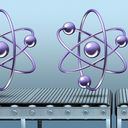Atomic energy makes its case as power needs grow

Don't call it a comeback — nuclear power has been here for years. Now, atomic energy's prolonged winter in the U.S. energy mix could finally be in for a thaw.
Why it matters: Fossil fuels comprise about 60% of the U.S. electricity generation mix, Energy Information Administration data shows, making the power sector particularly carbon-intensive.
- With the artificial intelligence boom taking shape and policymakers hoping to bring more electric vehicles online, nuclear power is seen as one of the more promising ways to power up without excess emissions.
- Yet for decades, domestic atomic energy development has been characterized by fits and starts because of high costs and safety fears.
Driving the news: Insatiable global demand for energy — and concerns that power-hungry AI computing may create a carbon-fueled catastrophe — could mean new momentum for nuclear power.
- Earlier this week, the Biden administration offered up $1.5 billion in loan guarantees to Holtec Palisades to restore a nuclear-powered electric plant in Michigan, part of "major milestones" the Energy Department expects this year for nuclear energy.
At CERAWeek in Houston last week, hopes for a nuclear "renaissance" were the talk of several different panels.
- While there was acknowledgment of the challenges the sector faces, the increasingly stark realities of a warming planet that's heavily reliant on fossil fuels figured prominently into those conversations.
What they're saying: "If you just look at the facts and the scenarios to get to 1.5 degrees … either a doubling or tripling of nuclear energy" is needed, said Dan Poneman, an ex-DOE official who currently co-chairs the Commission on Nuclear Energy and Climate Security.
- Citing the coral bleaching devastating parts of the world, he called for more public and private funding for nuclear power.
- "If we don't do this, we will incinerate the planet," he warned.
- Grant Isaac, EVP and CFO at Canadian uranium company Cameco called for mass construction of atomic power. "Don't build just one!"
Zoom out: The story of atomic power has largely been one of the U.S. vs. everyone else.
- Much of the action has taken place internationally, with around 60 reactors being built this year and at least 100 more planned, according to the World Nuclear Association.
Yes, but: Natural gas and renewable energy dominate the U.S. electrical mix. According to Federal Energy Regulatory Commission data, massive gains in solar and wind have boosted total available U.S. renewable generating capacity, eclipsing the pace of coal and nuclear.
- And as of January, there were exactly zero new domestic nuclear builds or expansions from the comparable year ago, FERC data shows.
The bottom line: On the one hand, atomic power is a minor player in U.S. power capacity dominated by natgas and clean energy, and it's unlikely that policymakers will let 1,000 reactors bloom.
- On the other, atomic energy has sunk so low on the energy policy menu that its upside is practically limitless.